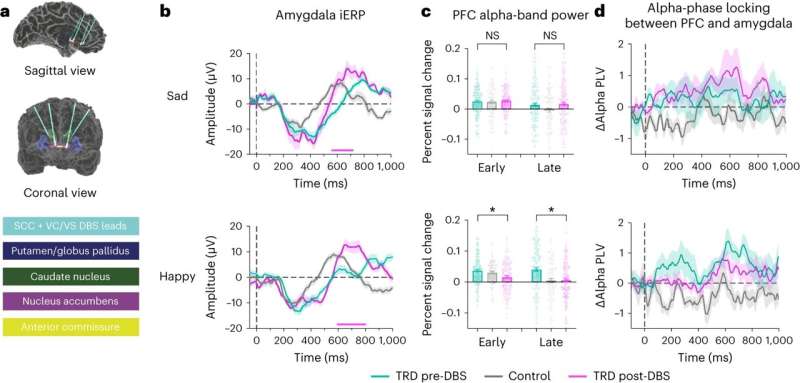
One potential underlying cause of symptoms in individuals with depression is an emotion-processing bias which causes them to have a stronger response to negative information more so than positive. While prior research has sought to further understand and treat the neural mechanisms behind these biases, many questions remain in the fight against treatment-resistant depression (TRD).
A new study led by a team of researchers at Baylor College of Medicine has recorded stereotactic electroencephalography signals (sEEG) in the amygdala and prefrontal cortex (PFC) of the brain from treatment-resistant depression patients to provide new insights into the foundational abnormalities that underlie depressive disorders. The study is published in Nature Mental Health.
Researchers focused on two types of processing known as bottom-up and top-down. Bottom-up processing is when sensory data or information comes into the brain, leading to a meaningful interpretation. Top-down processing involves using existing knowledge and expectations to interpret incoming sensory information.
The amygdala and prefrontal cortex play key roles in threat detection and response, a process that involves bottom-up and top-down processing. A person not living with TRD is able to balance both processes for efficient emotional processing.
The study, which compared sEEG signals in the amygdala and PFC from TRD patients and epilepsy patients, noted that “the timings of activations in the amygdala and the orbitofrontal subregion of the frontal lobe, relative to positive and negative emotional stimuli, suggests that treatment-resistant depression impacts top-down and bottom-up processing causing an imbalance,” said corresponding author Dr. Kelly Bijanki, associate professor of neurosurgery.
Bijanki further explained, “In depressed patients, we see increased responsiveness to sad stimuli in the amygdala (bottom-up response to salient stimuli). We also see decreased amygdala response to happy stimuli corresponding with an increase in inhibitory activity in the orbitofrontal cortex after a processing delay (suggesting abnormal top-down processing).”
The findings of the study could not have been collected without the use of human intracranial EEG, which “provides anatomically precise information about the temporal dynamics of neuronal population activity at the millisecond scale,” noted first author Dr. Xiaoxu Fan, a postdoctoral associate in Bijanki’s lab.
“This allowed unprecedented insight into the precise neural dynamics of emotional processing and provides a nuanced view of the pathophysiological state underlying the disorder,” said Bijanki.
The group also observed that deep brain stimulation (DBS) altered the neural responses to emotional stimuli by causing a disruption in the abnormal top-down inhibition of neural responses.
“Our results show that the altered neural responses to positive information can be relieved by DBS. Additionally, DBS can change negative information processing in a different way. Thus, DBS treatment may have different effects on positive and negative emotional processing in TRD patients.”
The findings of this study leave the group optimistic about what this could mean for TRD patients.
“In the future, we hope this finding can help define the disease entity of depression, and perhaps be used as a marker of effective therapeutic response to treatment,” Bijanki said.
More information:
Xiaoxu Fan et al, Brain mechanisms underlying the emotion processing bias in treatment-resistant depression, Nature Mental Health (2024). DOI: 10.1038/s44220-024-00238-w
Citation:
Understanding the brain mechanisms behind emotion processing bias in treatment-resistant depression (2024, April 17)
brain-mechanisms-emotion-bias-treatment.html
.
. The content is provided for information purposes only.
